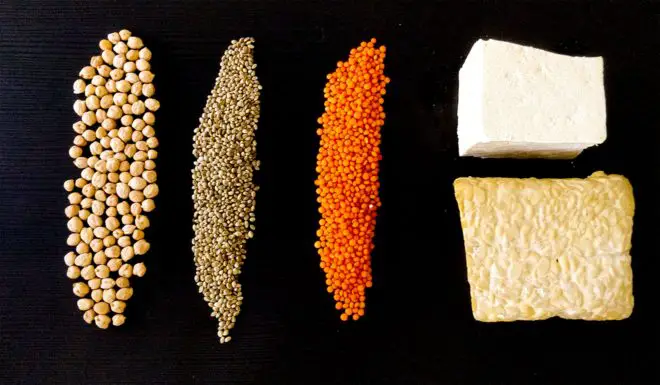Make Tempeh in a food dehydrator? Why not?
Here at Dry Food Craze, we cannot emphasize enough that having a food dehydrator at home is worth the investment because of its many uses other than drying foods.
In this article, we will feature another unusual use for a food dehydrator: making tempeh. Plus we’ll share a simple recipe.
Table of Contents
What is Tempeh?
Tempeh (or tempe) is a traditional Indonesian food made from fermented soybeans. The fermentation process uses a special fungus called Rhizopus oligosporus, usually marketed as Tempeh Starter which promotes binding the soybeans to create a cake-like form. Fermenting it requires maintaining a warm temperature at around 88°F for 24 to 48 hours. That’s why having a food dehydrator is useful.
Tempeh vs. Tofu
But you might be more familiar with another soybean product: tofu. Yes, tempeh and tofu come from soybeans and both are nutritious. But there are many differences than similarities between the two.
For one, tempeh is Indonesian in origin, while tofu has its roots from China.
Another difference is the way they are processed. Tempeh is made from fermented soybeans. Tofu, on the other hand, is made from curdled soy milk. That’s why tofu is also called soy cheese or bean curd.
Another difference would be the taste and texture. Tempeh is meaty in flavor and firm, while tofu is almost tasteless and spongy.

How to Make Tempeh Using a Food Dehydrator
You would need a meat thermometer with an alarm as it will warn you if the temperature becomes out of range. When taking temperature, insert it directly into the beans.
INGREDIENTS:
- 2 cups dry soybeans, hulled
- 2 Tbsp. vinegar
- ¾ tsp. (1 packet) Tempeh Starter Culture – Check on Amazon
PROCEDURE:
- Boil the soybeans for 1 hour.
- Discard the cooking water and dry the beans by patting them dry using a towel. It is important to dry the beans to the touch.
- Place beans in a dry bowl and allow to cool to lukewarm or skin temperature.
- Add the vinegar and mix well.
- Add the tempeh starter and mix evenly.
- Place the beans in vented containers. The beans should be layered in 1 to 1½ inches thick.
- Incubate the beans in a food dehydrator at 85°F to 91°F for 24 to 48 hours. It takes at least 30 hours for soybeans to culture. Ideally, the soybeans should ferment at 86°F to 88°F.
- Monitor the temperature for the first 12 hours to make sure it stays stable at 86°F to 88°F. After 12 hours, the beans start to generate their own heat so you may need to reduce or eliminate the source of external heat.
- Check again at 24 and 36 hours. Tempeh usually takes 48 hours to culture and may take longer if the temperatures are low.
- After 24 hours, the white mycelium starts to cover the surface of the beans. After a few hours, the mycelium will grow through the beans and will start to smell nutty.
- After 30 to 48 hours, the beans have become a single mass held together by the white mold and may have spots of black or grey mold as well especially near the vent or holes. It will have a pleasant nutty aroma and warm without the aid of any heating device.
How To Stop The Fermenting Process
We mentioned a while ago that tempeh produces its own heat due to the fermentation process that took place. It will continue to do so unless you put a halt to it. There are several ways to stop the process:
- Refrigeration – This is the simplest and straightforward method. However, keep the tempeh cakes separate to make sure they cool evenly. It is not recommended to stack them because it will continue to produce heat.
- Freezing – Plunge tempeh in boiling water for 30 seconds then wrap them individually. Freeze up to 12 months.
- Boiling – Bring water to boil. Add salt, herbs or spices of your choice. This is a good way to flavor it while preparing for storage. Boil the tempeh for 30 to 60 seconds. Cool, wrap, and refrigerate.
- Baking – Brush with marinade or dressing of your choice and bake at 350°F for 20 minutes. Cool and store in a covered container in the refrigerator.

Storage
Tempeh lasts up to 10 days inside the refrigerator and up to 12 months in the freezer.
Tempeh can also be dried in a food dehydrator. Slice them evenly and arrange them on dehydrator sheets as you would with other food. You may season them with herbs or spices of your choice before drying. Dry until they become firm or crisp. Keep them in an airtight container and store in a cool, dark place.
Tempeh Goreng
Tempeh, on its own, can be steamed, fried, or grilled. Marinades usually impart flavor to the slices because it doesn’t have a strong flavor.
Tempeh can also be used as a substitute for ground meat in soups or stews.
The simplest method of cooking tempeh is to fry them in a pan and dip in your favorite dipping sauce. Slice and season it with a mixture of ground garlic, coriander seeds, and salt. Deep fry in hot oil. For a variety, you might want to coat tempeh in a batter before frying.
Final Thoughts
Incubating soybeans in a food dehydrator to make tempeh is another unusual way to use this multi-purpose kitchen appliance. It is sure worth an investment so if you’re considering buying a food dehydrator, check out our recommendations.


